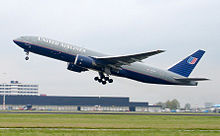Entry into service
Boeing delivered the first 777 to United Airlines on May 15, 1995.[54][55] The FAA awarded 180-minute ETOPS clearance ("ETOPS-180") for the Pratt & Whitney PW4084-engined aircraft on May 30, 1995, making it the first airliner to carry an ETOPS-180 rating at its entry into service.[56] Longer ETOPS clearance of 207 minutes was approved the following October.[57] The first commercial flight took place on June 7, 1995 from London Heathrow Airportto Dulles International Airport near Washington, D.C.[58]
On November 12, 1995, Boeing delivered the first model with General Electric GE90-77B engines to British Airways,[59] which placed the aircraft into service five days later.[60] Initial service was affected by gearbox bearing wear issues, which caused the airline to temporarily withdraw its 777 fleet fromtransatlantic service in 1997.[60] British Airways' aircraft returned to full service later that year,[50] and General Electric subsequently announced engine upgrades.[50]
The first Rolls-Royce Trent 877-powered aircraft was delivered to Thai Airways International on March 31, 1996,[59] completing the introduction of the three powerplants initially developed for the airliner.[61] Each engine-aircraft combination had secured ETOPS-180 certification from the point of entry into service.[62] By June 1997, orders for the 777 numbered 323 from 25 airlines, including satisfied launch customers that had ordered additional aircraft.[47] Operations performance data established the consistent capabilities of the twinjet over long-haul transoceanic routes, leading to additional sales.[63] By 1998, dispatch reliabilityfigures had reached a 99.96 percent rate of takeoff without delay due to technical issues,[64] and the growing number of fleet hours approached 900,000.[64]








0 komentar:
Posting Komentar